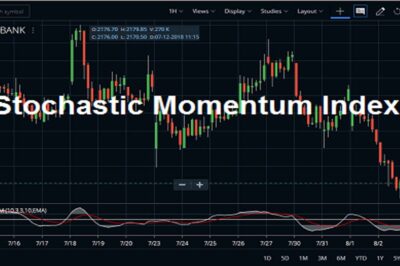
FAQ’s:
Q: What is the Stochastic Momentum Index (SMI)?
A: The Stochastic Momentum Index (SMI) is a technical momentum indicator used in financial markets to measure the closing price’s relationship to its price range over a specific period of time. It aims to provide signals for potential trend reversals or continuations.
Q: How is the SMI calculated?
A: The SMI is calculated using the formula: SMI = 100 * (Close – Lowest Low) / (Highest High – Lowest Low) Where:
i. Close: The closing price of the asset.
ii. Lowest Low: The lowest low price within a specified look-back period.
iii. Highest High: The highest high price within the same specified look-back period.
Q: What is the significance of the SMI?
A: The SMI helps traders identify overbought and oversold conditions in the market. It oscillates between +100 and -100. Readings above +40 are considered overbought, while readings below -40 are considered oversold.
Q: How is the SMI different from the traditional Stochastic Oscillator?
A: The SMI is an advanced version of the traditional Stochastic Oscillator. It differs in its calculation method, incorporating the concept of the Stochastic Oscillator with the addition of a smoothing function to reduce false signals.
Q: What are the components of the SMI?
A: The key components of the SMI are:
%K Line: Represents the current price’s position relative to the price range.
%D Line: A smoothed version of the %K Line, typically a simple moving average of the %K Line.
Signal Line: A moving average of the %D Line, often used for generating trading signals.
Q: How is the SMI interpreted for trading signals?
A: Trading signals are generated based on crossovers and divergences between the SMI lines (%K, %D, and Signal Line). Bullish signals occur when the %K line crosses above the %D line, while bearish signals occur when the %K line crosses below the %D line.
Q: What are some strategies for using the SMI?
A: Some common strategies for using the SMI include:
i. Identifying overbought and oversold conditions for potential trend reversals.
ii. Using signal line crossovers for entry and exit points.
iii. Combining SMI signals with other technical indicators for confirmation.
Q: Can the SMI be applied to different timeframes?
A: Yes, the SMI can be applied to various timeframes depending on the trader’s preferences and trading style. Shorter timeframes may provide more frequent but less reliable signals, while longer timeframes may offer more reliable signals but fewer trading opportunities.
Q: Are there any limitations to using the SMI?
A: Like any technical indicator, the SMI is not infallible and may generate false signals, especially in ranging markets. Additionally, it’s essential to consider other factors such as market fundamentals and news events when making trading decisions.
Q: How can I incorporate the SMI into my trading strategy?
A: To incorporate the SMI into your trading strategy, consider backtesting it on historical data to understand its performance characteristics. Additionally, practice using the SMI on a demo account before applying it to live trading to gain confidence and refine your approach.







